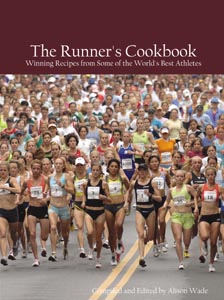| |
|
|
|
|
Training Tipsby James E. Fields, Ph.D. (Editor, Women's Steeplechase Report) | STEEPLERS BASE
When the cooler weather of Autumn arrives, it's time for steeplers to rebuild their fitness base with off-track workouts, ideally without much racing pressure. The two base workouts, endurance and strength, are done on different days. Each week should include rest days as needed.
Endurance: A classic formula has been 2.5 times the track racing distance at an enjoyable pace on a pleasant, possibly scenic course. For 3000m steeplers that would be 7500 meters, about 4.66 miles. With a warmup kilometer jog and stretching, before and after the run, the day's total is 9500 meters.
Strength: This requires more warmup, as much as two miles of jogging for some runners plus stretching. Then it's time to run repetitions on a modest slope hill of about 300 meters that can be run in 60 to 70 seconds -- at or near the athlete's steeplechase pace. Beware of steep hills that can slow the pace. It's not necessary to time more than one of the repetitions in each workout.
(How many repetitions? Let the runner decide what feels right; but repetitions commonly come in sets of no less than three nor more than ten. What if the only available hill is shorter, perhaps 200 meters? Enjoy that distance but try running a bit faster than the pace described above for a 300-meter hill.)
This combination is not intended to prepare an athlete for intense cross country competition which has become a separate sport, lacking appeal or utility for some steeplers. They may prefer a day each week to maintain hurdling skills -- practicing with lightweight hurdles rather than steeple barriers. |
SPEED
Steeplers may develop their cardio-vascular endurance by cross-country competition, particularly short-course races of 4 to 6 km. Preparation for a spring/summer steeple season is further enhanced by developing event-specific skeletal-muscular endurance need to clear steeple barriers, particularly at the water jump..
The 400m hurdles with 10 barriers have long been characterized as an extremely tiring event, but steeplers face far more barriers -- as many as 35 in a 3000m steeplechase. Further, the non-tipping design of steeple barriers (and their weight, ranging from 80 to 100 kg) creates potential for injury if /when muscular fatigue hampers the athlete's ability to clear the barriers.
Most nations use shorter distance steeple races for young, developing athletes (juniors) as well as those of advanced age in "seniors" or "veterans" competition. Even the 16 barriers of a 1500m steeple, or the 23 barriers of a 2000m steeple, are very demanding for runners lacking fully developed muscular endurance.
Speed helps. We have observed that, for quality clearances, lady steeplers generally require a pace of at least 22 seconds per 100m (11 minutes for 3000m steeplechase). A slower overall pace requires compensatory acceleration on the approach to each barrier, particularly the water jump. Such acceleration was observed for even faster runners such as Russia's Svetlana Rogova as she won the 1998 Goodwill Games steeple in 9:57.62.
Practice clearances, using regular tipover hurdles instead of the heavier steeple barriers, should include speed. For "interval" work in clearances, set up 5 hurdles about 80 meters apart to approximate 400 meters of a steeple race; then, as is common for intervals, run that 400m lap --followed by a walking recovery before the next 400m run with 5 hurdles.
Three variables can be adjusted throughout the training season: increasing the pace at which the 400m lap is run, decreasing the recovery time from an initial three minutes, and increasing the number of those 400m runs with their 5 hurdles. This workout does not include clearances of water jump barriers, for which most steeplers use a different technique -- and sometimes without water -- discussed in another Training Tip. |
WATER JUMP
Most steeplers use a different technique for water-jump barriers than for on-track barriers. We have observed three techniques for clearance of steeple barriers: hurdling, vaulting with use of hands atop the barrier, or stepping atop the barrier and then pushing off that top in a forward motion via propulsion from one foot.
Existing rules, though worded imprecisely, neither prohibit nor favor any of these techniques. However, observation reveals trends: Most steeplers, but not all, use the first technique (hurdling) for on-track barriers. Most, but not all, use the third technique (step and push) for water jump barriers.
Although we have seen and photographed athletes vaulting barriers, and recognize its rare use to recover from unexpected deceleration on the approach, we do not analyze that technique.
Some limited research suggests that hurdling produces the fastest clearance of a water jump barrier but is slower (than step and push) for exiting the water. Because hurdling a fixed (unmovable) water jump barrier increases the potential for injury, this Training Tip focuses on step and push technique at the water jump barrier.
The circumstances of racing do not assure uniformity of speed or stride length on the approach, let alone finding and using a check mark in the manner of field event jumps. But such check marks, and a quest for uniformity of speed and stride length, can be helpful in practice -- particularly for novice steeplers. As noted in another Training Tip, it appears that good barrier clearance needs a maintained speed of at least 2.2 seconds per 10 meters. Athletes should acquire the "feel" of a good clearance pace which may be faster than their overall race pace.
Steeplers need also to develop an ability to use either foot to propel themselves from the ground and to push off from the barrier toward the departure end of the water pit. Approaching the barrier in a race crowd limits the opportunity to plant a favored foot in a favored place.
Landing after barrier clearance can too easily include a braking action with shock, exacerbated by modern steeple pits with their sloped-floor surface. If the athlete's center of gravity is behind the landing foot, the next stride or two will be shortened -- causing a slow exit from the water. Coaching an athlete to "reach for distance" on landing, as in a long jump, is inappropriate for the water jump because steeplers must maintain speed for exiting the water pit and continuing swift forward running motion. Three fast steps are better here than a slow two.
To reduce practice-landing shock, with the sloped pit surface comparable to "hitting the wall", an on-track steeple barrier can be positioned for landings on a grass infield surface or even into the sand of a long jump pit. Water jump barrier practice may work best for some steeplers as a separate session, not on the same day as hurdling practice on the standard 400-meter oval.
Barrier clearance practice and training includes developing skeletal-muscular endurance because steeple races require far more clearances than short hurdle races of 400 meters or less: 16 barriers for 1500m steeple, 23 barriers for 2000m steeple, and 35 barriers for 3000m steeple. This is a critical variable for training programs, and for decisions regarding appropriate race distances, particularly for developing steeplers. |
WATER HURDLING ANALYSIS
In a previous Training Tip we said that most, but not all, steeplers traverse the water jump barrier by stepping on it and then pushing off from the barrier's crossbar in a forward motion via propulsion from one foot. We added that some limited research suggests that hurdling the barrier produces a faster clearance than step and push.
However, that previous Training Tip focused on step and push because "hurdling a fixed (unmovable) water jump barrier increases the potential for injury." Yet there are steeplers who hurdle that water jump barrier, just as they do the on-track steeple hurdles, and some have done very well.
Clare Martin won the steeple at BMC Grand Prix in June 2003 at Eton, England, where observer Tim Grose reported that she "hurdled all the water jumps; in doing so she seemed to get through the water quicker than the others who employed more traditional techniques."
Dawn Cleary (University of Virginia) is one of five USA women to break 10 minutes for 3000m steeple in 2003. By hurdling the seven water jumps she employs the same technique used for the 28 on-track hurdles.
Billy Harper, best USA schoolboy steepler in the mid-1990s, mixed techniques in the same race -- hurdling some barriers and stepping on others. When I asked his reason, Billy said it was determined by his foot placement just prior to each water jump.
(In short hurdle races of 400 meters and less, the athletes have a lane of hurdles to themselves and they target a set number of strides between each clearance. Steeplers do not enjoy the security of lanes; instead, a dozen or more of them may arrive in a pack at one barrier spanning four lanes -- and compete there for limited space to attempt a clearance with ad hoc techniques.)
I have seen other barrier clearance variations in different countries. Perhaps the most unusual was an African steepler, in the IAAF Grand Prix finale in 1995 at Monaco, who tucked both feet under his body in the manner of some animals leaping an obstacle.
Four anecdotal examples do not a theory prove. Nor might a dozen although some "research" in athletics has been published with an even smaller population. It can be more conclusive to examine photographs, still and motion, of 50 to 100 steeplers showing their water jump approach, clearance, landing, and exit from the water.
Photography offers opportunities for repeated observations and study of the same phenomena. That includes timing the interval from starting a clearance to landing, pit position of landings and related angle of the runner's body at impact, number and length of steps in the water plus elapsed time there, and exit from the departure end of pit.
Televised coverage of track meets, often employing multiple camera locations that include side views of most events, can offer an excellent source of technique for study by athletes and coaches. Regrettably, the steeplechase water jump is an exception. A standard TV procedure is to switch from a side view camera to head-on just as the steeplers prepare to leave the ground at the start of barrier clearance. The next image is of the steeplers descending into the water and running directly toward the viewer, hardly a model for students of the event but a sure source of exaggerated "splash photos" when the camera lens is held low near the water surface. Only one sure observation flows from this TV procedure: Many good steeplers produce more than one splash, taking more than one step in the water.
Personal observations and photos of steepling from my coaching years have been instructive, but we could learn much more if network TV included some side views of the water jump -- perhaps including slow-motion replay as is done with sprint hurdle races. |
|
Home | About Us
|
| |

Steeple Chics Store:
Get cool stuff, promote the steeplechase |


The Runner's Cookbook

Proceeds go to the Ryan Shay Memorial Fund & Jenny Crain "Make it Happen" Fund |
Donate to the
Jenny Crain
Make It Happen Fund

http://www.jennycrain.net |
Website Design & Creation:
 |
|



